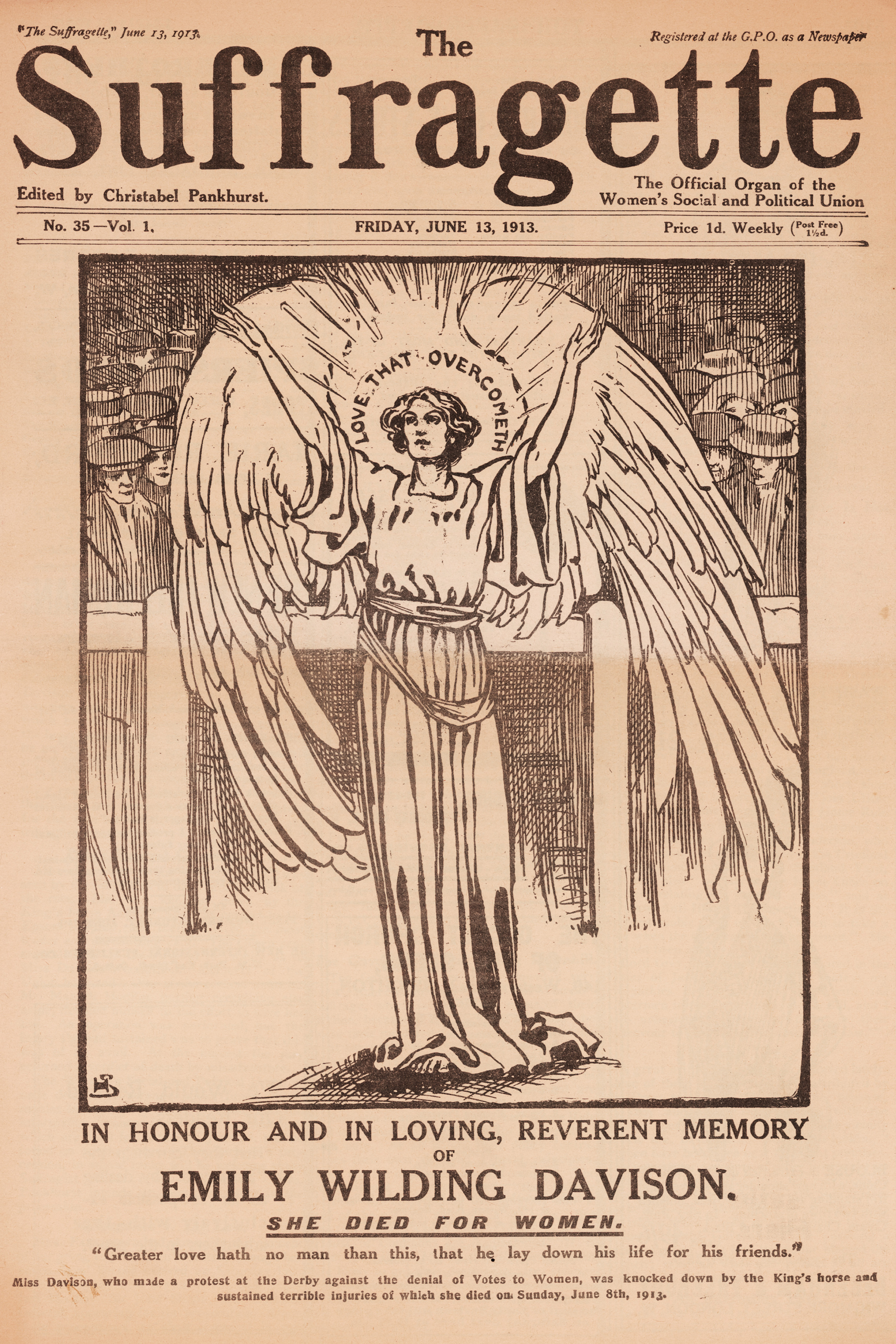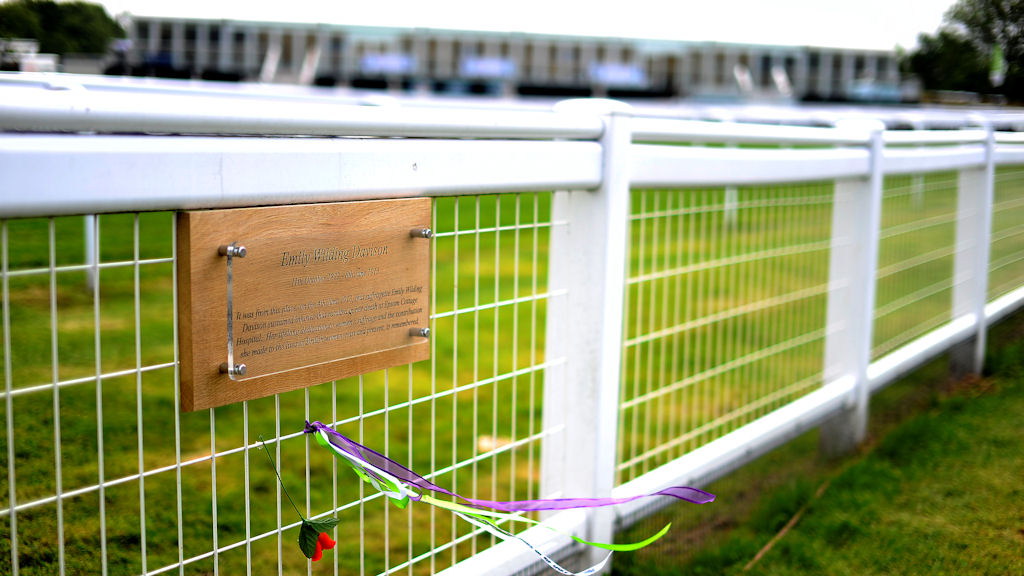Emily Wilding Davison: terrorist, ‘battleaxe’, heroine?
It is probably the most famous act in the history of the suffragette movement – Emily Wilding Davison falling under the King’s horse at the Epsom Derby. But her legacy is altogether more complicated.
One hundred years ago, Emily Wilding Davison ducked under the fences at Epsom and moved into the path of the horses thundering down the racecourse.
What happened next (above) is still shocking despite the grainy footage and the passage of time. She fell under the King’s horse and later died of the injuries she sustained. In doing so, she became a martyr for her cause: votes for women.
The suffragettes made her funeral a major protest event, taking the coffin on a procession through the streets of London and asking people to dress in black and carry flowers.
The impact of her act in terms of actually moving on the cause is debatable – the first world war began the next year and the suffragettes paused their campaign to stand united with the country. Indeed, the work done by women during the war was certainly one of the key factors in winning them the vote by 1918 – if only for those over 30. Ten years later the age was reduced to 21, the same as men.
But Davison certainly became a symbol, an icon – which is probably why her legacy remains hotly debated to this day. In fact, for some historians, the way she is described even in 2013 can be a sign of how much further the equality movement has to go.
Professor June Purvis of the University of Portsmouth is a suffragette expert who describes herself as “horrified” by the language used to describe Davison in a new book by racing historian Michael Tanner called The Suffragette Derby.
I described her as a bit of a battleaxe. Michael Tanner, author of The Suffragette Derby
“‘Emily Wilding Davison appears a bit of a battleaxe…she’s a frumpy, old before your time, gone to seed woman,'” quotes Professor Purvis. “That’s the kind of language used at the time to describe them – riled, menopausal, mad women. They didn’t see them as serious political players. But this is 2013.”
But Mr Tanner told Channel 4 News his language was not intended to inflame.
“That’s what she looked like and that’s how she behaved,” he said. He says the pictures used of Ms Davison as a young woman are all part of the myth-building that has grown up around her since 1913.
“She was extraordinarily clever, extraordinarily brave, extraordinarily wilful. But these elements are not always translated into the planning and execution of her suffragette exploits. Which is why she ended up getting killed,” he said.
At the same time as describing Davison’s act as “senseless”, Mr Tanner also defends his description of her looks.
“I described her as a bit of a battleaxe – I cannot swallow whole the perfect image that has been portrayed. The evidence is there – you couldn’t for example endure 49 bouts of forcible feeding over a couple of years [without being a bit of a battleaxe],” he said. Instead, he thinks of her as an “accidental martyr”.
He said: “From the point of view of history, posterity gave her the glorious immortality the movement required.”

Terrorists?
When talking about people or organisations who commit violent acts and who want to build myths around themselves, it is hard not to think about terrorists.
Indeed, several historians have explicitly compared Ms Davison and other suffragettes to terrorists, with their campaign of bombings and arson, albeit in empty properties and never intending to kill or hurt individuals.
Historian and author Dr Diane Atkinson, who has caused controversy in the past with her descriptions of Davison, told Channel 4 News: “I can imagine her as being our first suicide bomber. If that starts another storm, great. It will make people think about it and take it more seriously.”
Dr Atkinson believes Davison’s act was a suicidal protest of huge significance.
“I think she did it to raise the stakes. To confront the British public with the fact that this woman was prepared to give her life for the vote. And I think that reminds us all of the shocking struggle women had to get the vote,” she said.

Part of the problem with arguing over Davison’s death is the ambiguity of whether it was suicide or not, a fact over which many disagree. Some point to her return train ticket, others point to her writings which featured references to martyrdom. Either way, she succeeded in what must have been one of her aims – to draw attention to herself, and her cause; to, in a way, create a myth around her which was bigger than one person or one act.
“Emily Wilding Davison is the most famous suffragette of all and that’s just how she would have loved it,” said Dr Atkinson.
Professor Purvis, however, believes that calling the suffragettes “terrorists” misses the point, and indeed plays into another myth about them which was prevalent at the time, and which she believes was reductive.
“I would completely refute that,” she told Channel 4 News. “There were some newspapers at the time which thought they were terrorists but these were written from a male perspective, seeing them as embittered women whose hormones were out of balance, who were doing irrational things.
“They didn’t see women as serious political players and I’m always very dubious of that.”
Emily Wilding Davison is the most famous suffragette of all and that’s just how she would have loved it. Diane Atkinson
Instead, she points out, the suffragettes never aimed to hurt or take life. Their protests escalated in violence in response to the undisputed horror of the forced feeding many suffragettes had to endure.
“They were fighting for a moral cause, a just cause. Through her [Davison’s] courage and endurance, she showed that physical force – even dying – could not overcome the justice of the cause,” added Professor Purvis.
Building the myth
It’s also worth remembering that Davison was just one element of the suffragette movement. They had been fighting, many completely peacefully, for almost 50 years at the time of her death. As historian Elizabeth Crawford put it: “It’s slightly galling that she’s the only one mentioned. There were plenty of others who had put their backs into it since 1866.”
But the drama of Davison’s act certainly catches the imagination – builds the myth, if you like – even if at the time most newspapers and even the royal family were more concerned with the welfare of the horse and jockey than Davison herself.
And it was this drama which allowed the suffragettes to use her image as a symbol to rally round – a symbol which definitely played its part in ultimately keeping votes for women in the headlines, and eventually onto the statue books.
And while the debate over whether she meant to kill herself, as well as the best way to label her – “battleaxe”, heroine, or terrorist – will no doubt continue, many also hope that elements of her fighting spirit infuse the battle for equality in the modern world.
Ceri Goddard, chief executive of the Fawcett Society, said: “Men outnumber women four to one in parliament, out of a cabinet of 23 there are only four women. We also lag behind much of the world – the UK ranks 58th in the world in terms of women’s representation… Emily Davison and her fellow campaigners – including our own Millicent Fawcett – would, I think, be staggered at this snail like pace of change.”
Professor Purvis agrees.
“We need to bring some of that fighting quality back into the women’s movement. There is a resurgence but women still have to fight sexism at work, in the media, in cultural life,” she said.
“I’m not saying we need a new Emily Davison but we do need a tremendous cultural shift towards equality.”
-
Latest news
-
Yungblud launches his own affordable music festival5m

-
Why these Americans want to quit their state9m

-
Company behind infected water outbreak are ‘incompetent’ says local MP5m

-
Israeli forces push deeper into Northern and Southern Gaza4m

-
India’s ‘YouTube election’: Influencers enlisted to mobilise youth vote6m

-




